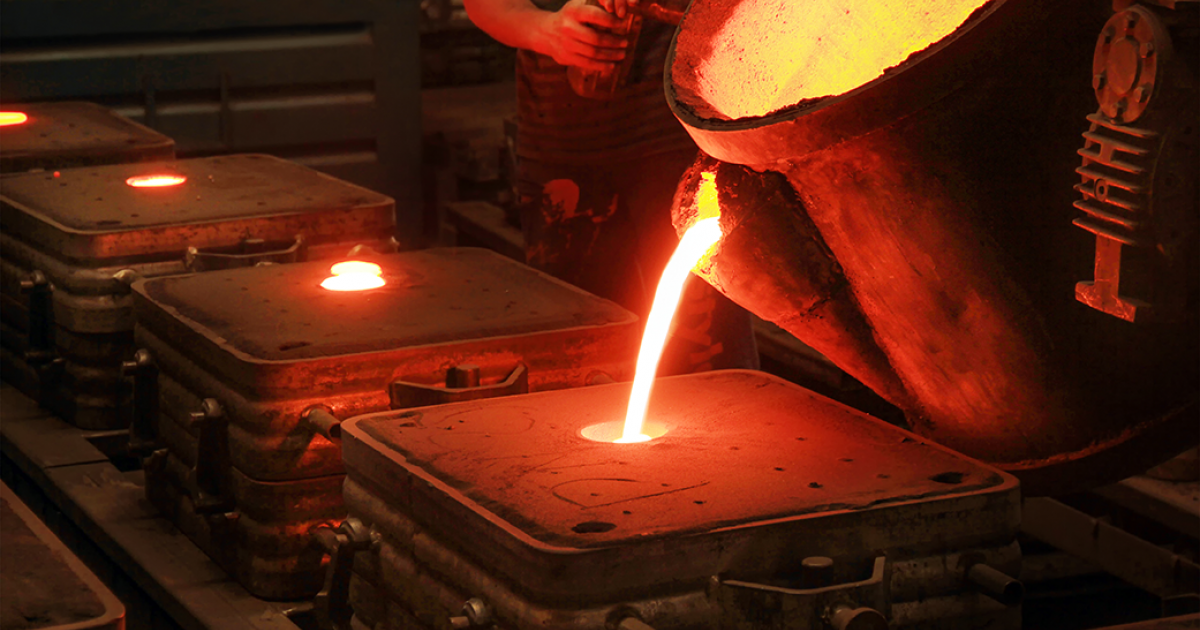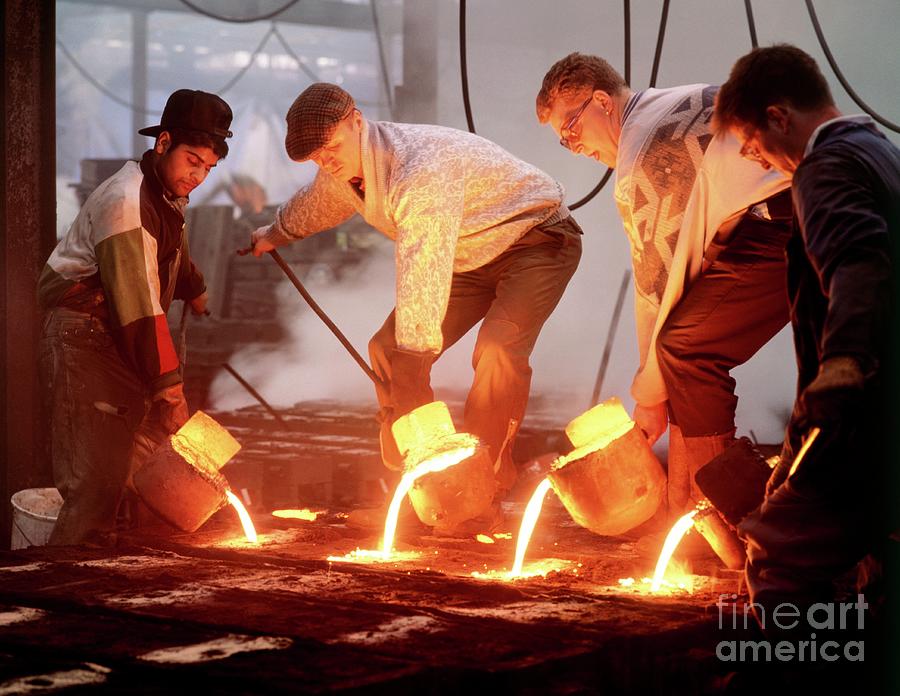Perfecting the Art of Aluminum Casting for Precision
Wiki Article
Everything About Metal Casting: Exactly How Foundries Provide Quality and Precision in Production
Metal casting stands as a fundamental process in manufacturing, where raw steels are transformed into particular components. Foundries utilize different casting methods to accomplish desired forms and features. Each technique includes its own set of benefits and constraints. Comprehending these subtleties is crucial for appreciating just how quality and precision are preserved throughout the procedure. The discussion ahead will certainly explore the complex characteristics of metal casting and its significance across several sectors.The Basics of Metal Casting
Metal casting is a fundamental process in producing that entails forming liquified metal into preferred types. This essential technique begins with the choice of basic materials, usually various metal alloys, which are melted in a furnace. When the metal reaches the suitable temperature level, it comes to be ready and liquid for casting.The process needs a mold and mildew, commonly made from sand, metal, or ceramic, which defines the last form of the actors object. When the liquified metal is put right into the mold and mildew, it strengthens and cools down, tackling the mold and mildew's shapes.
After cooling down, the casting is gotten rid of from the mold and mildew, and any kind of essential ending up procedures, such as cutting or brightening, are carried out. This technique enables producers to create intricate forms and parts with high precision and very little waste. Metal casting is commonly used across different markets, from vehicle to aerospace, highlighting its relevance in modern-day production.
Kinds Of Casting Techniques
While numerous casting techniques exist, each strategy offers special advantages and is suited for different applications. Sand casting, among one of the most typical methods, makes use of sand as the mold and mildew material, enabling huge parts and intricate layouts. Investment casting, known for its precision, uses a wax pattern coated in ceramic, making it perfect for intricate geometries. Die casting, which involves requiring molten metal right into molds under high stress, is frequently made use of for automation of small, thorough elements. Additionally, shell molding incorporates sand and material to create thinner, a lot more accurate mold and mildews, improving surface coating. An additional technique, continuous casting, enables the production of long sizes of metal shapes, improving manufacturing processes. Each of these methods plays a pivotal duty in the metal casting sector, addressing certain requirements from production quantity to make intricacy, consequently adding to the variety of applications across various markets.The Function of Foundries in Manufacturing
Foundries offer an important feature in the production landscape, as they change raw steels into usable components via different casting procedures. These facilities utilize an array of techniques to produce items that fulfill accurate specifications, thus ensuring high quality and performance in production (Aluminum Foundry). By utilizing approaches such as sand casting, financial investment casting, and die casting, foundries cater to diverse markets, including vehicle, aerospace, and building
Inevitably, foundries are indispensable to the manufacturing ecological community, offering critical elements that sustain a broad array of applications and sectors. Their precision and flexibility drive efficiency in modern-day manufacturing.
Products Made Use Of in Metal Casting
The choice of products used in metal casting is necessary for achieving the preferred homes and efficiency of the end product. Various metals such as iron, aluminum, and bronze are frequently employed, each offering distinctive advantages. Light weight aluminum is preferred for its lightweight and corrosion-resistant top qualities, making it optimal for automobile and aerospace applications. Iron, particularly cast iron, is recognized for its outstanding fluidness and strength, ideal for heavy equipment and infrastructure elements. Bronze, with its superior wear resistance, is frequently made use of in marine environments.Furthermore, materials such as silica sand are often utilized for mold and mildew production, providing a great balance between toughness and convenience of shaping. The choice of products likewise consists of ingredients like changes, which boost the casting procedure by enhancing fluidness and minimizing oxidation. Inevitably, the ideal option of these products greatly affects the performance and top quality of the casting procedure.
High quality Control in the Casting Process
Quality control in the casting process is vital to ensure that end products fulfill sector requirements and specs. Various inspection techniques are used to determine problems and assess the integrity of cast components. Additionally, adherence to developed qualifications and requirements improves the dependability and performance of actors products.Assessment Techniques Employed
Preserving the stability of cast metal elements counts heavily on numerous examination methods. Foundries utilize visual evaluations as an initial step to recognize surface area flaws, such as additions or cracks. Non-destructive screening (NDT) techniques, including ultrasonic screening and radiographic assessment, are vital for spotting internal imperfections without jeopardizing the component's honesty. Dimensional assessments using calipers and coordinate measuring equipments confirm that components satisfy defined tolerances. In addition, chemical analysis validates that the alloy structure aligns with required requirements. These evaluation methods collectively validate that the castings meet the essential quality and efficiency criteria, eventually decreasing the risk of failing in their intended applications. Carrying out these rigorous assessments is fundamental for preserving high criteria in metal casting manufacturing.Criteria and Certifications
Requirements and certifications play a crucial function in the top quality control of the casting process. Foundries follow different global and industry-specific requirements, such as ISO 9001 and ASTM standards, guaranteeing consistency and dependability in their items. These criteria outline the required requirements for materials, manufacturing approaches, and screening procedures, adding to a more efficient manufacturing process. Accreditations, such as AS9100 for aerospace applications, additionally stress the relevance of quality control in specialized markets. By getting these credentials, foundries demonstrate their dedication to quality, lowering defects and enhancing client satisfaction. Regular audits and evaluations verify conformity, fostering constant renovation and advancement within the sector. Eventually, adherence to developed requirements cultivates depend on in between customers and suppliers.Developments in Casting Modern Technology

3D Printing Integration
Integrating 3D printing modern technology right into metal casting processes is transforming the production landscape. This cutting-edge fusion improves the layout and manufacturing of intricate geometries that conventional techniques battle to achieve. By employing additive manufacturing for see this developing cores and mold and mildews, shops can significantly minimize preparations and material waste. In addition, 3D printing allows for fast prototyping, making it possible for producers to evaluate layouts rapidly and successfully, thereby assisting in repetitive improvements. This modern technology likewise supports the manufacturing of light-weight elements, which are essential in industries like aerospace and automobile. Therefore, the integration of 3D printing not only improves operations however likewise raises the precision and high quality of cast metal products, noting a noteworthy development in the market.Automated Production Processes
The advancements in 3D printing have actually led the method for more technologies in computerized manufacturing procedures within metal casting. Foundries are significantly taking on robotics and automation to boost performance and precision. Automated systems simplify the whole casting process, from mold production to pouring and ending up. Smart sensing units and real-time tracking enable specific control of temperatures and product flow, reducing waste and enhancing quality. Furthermore, software options help with far better design and simulation, making it possible for manufacturers to enhance processes before manufacturing begins. These automatic manufacturing processes not just lower labor expenses yet also lessen human mistake, guaranteeing regular output. Therefore, the assimilation of sophisticated technologies in metal casting is transforming manufacturing capabilities and meeting the expanding needs of various markets.Advanced Product Growth
As sectors require higher performance and sustainability, developments in material advancement for metal casting are arising as an essential emphasis. Engineers and researchers are exploring new alloys and composites that enhance mechanical residential properties while minimizing ecological influence. Technologies consist of light-weight products that keep toughness, making it possible for far better gas efficiency in transport applications. Additionally, the incorporation of recycled materials is coming to be extra widespread, lining up with sustainability objectives. Advanced casting methods, such as 3D printing and precision molding, permit for the production of intricate geometries that standard approaches can not achieve. These developments not just improve the functionality of cast parts yet additionally improve manufacturing effectiveness. Generally, the constant evolution of product scientific research drives the future of metal casting, satisfying the demands of modern sectors.
Applications of Metal Casting Throughout Industries
Metal casting plays an essential role in various markets, as it enables the manufacturing of complicated forms and top quality elements with family member effectiveness - Metal Foundry. In the auto market, cast steels are crucial for developing engine blocks, transmission situations, and other crucial parts that need resilience and precision. Aerospace sectors use metal casting for parts like wind turbine blades and architectural aspects, where dependability is criticalIn addition, machinery and devices production benefit from metal casting by generating gears, real estates, and various other elaborate components that enhance performance. The construction market additionally employs metal casting for building features, structural assistances, and installations, showcasing flexibility.
The medical area counts on cast metals for medical tools and implants, emphasizing the requirement for biocompatibility. On the whole, metal casting is a foundational procedure across several markets, providing services that satisfy rigid top quality standards and performance requirements.
Often Asked Concerns
What Precaution Are Taken in Metal Casting Foundries?
In metal casting foundries, safety steps include protective gear, ventilation systems, normal tools maintenance, employee training, and emergency procedures to alleviate dangers linked with high temperature levels, unsafe materials, and potential accidents during the casting process.How Do Foundries Manage Waste and Environmental Influence?
Foundries take care of waste and ecological influence via recycling products, applying filtration systems for emissions, and sticking to policies - Metal Foundry. They additionally take on sustainable techniques, such as reducing power consumption and using environmentally friendly compounds in their processesWhat Are the Costs Connected With Metal Casting Processes?
The expenses related to metal casting processes consist of check these guys out resources, labor, equipment upkeep, power usage, and waste management. In addition, variations in market value and compliance with ecological policies can significantly impact general expenses for shops.Exactly How Does Metal Casting Compare to Various Other Manufacturing Methods?
Metal casting supplies unique benefits, such as complicated forms and high material performance, compared to approaches like machining or stamping. Nonetheless, it might involve longer lead times and greater first expenses, relying on job requirements.
What Career Opportunities Exist in the Metal Casting Market?
The metal casting industry uses numerous profession possibilities, including factory Recommended Reading monitoring, process design, quality assurance, mold and mildew style, and equipment operation. Professionals can likewise pursue functions in r & d, sales, and environmental health and wellness.Metal casting stands as a foundational procedure in manufacturing, where raw steels are changed into certain parts. Metal casting is a fundamental procedure in manufacturing that includes shaping liquified metal right into desired types. Another technique, continuous casting, allows the manufacturing of long sizes of metal shapes, streamlining production procedures. The costs connected with metal casting procedures consist of raw materials, labor, equipment upkeep, power intake, and waste management. The metal casting industry offers various profession chances, consisting of factory administration, procedure design, high quality guarantee, mold and mildew style, and equipment operation.
Report this wiki page